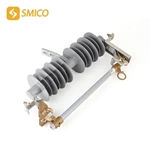The Difference Between Drop-out Fuses And Circuit Breakers In Application
The difference between cover drop out fuse and circuit breakers
What are the differences between drop fuse and circuit breakers? Let the editor of drop fuse cutout manufacturer tell you!
1. Convenience of use and maintenance
In low-voltage power distribution terminals, electrical faults may be caused by overload or other reasons. Miniature circuit breakers can be closed after overload, and their operation is simple, so it is more appropriate to use small circuit breakers as protective electrical appliances. For drop out expulsion fuse switches, drop out fuse 22kv must be replaced before they can be put back into use. Sometimes there is no suitable drop out fuse 33kv for replacement.
However, for low-voltage power distribution systems and ordinary low-voltage cabinets maintained by professionals, circuit breakers do not have these advantages. First of all, faults do not occur frequently in these places; secondly, it is very dangerous to close the circuit breaker directly without checking after a fault occurs, especially a short-circuit fault. drop out fuse cut out has different states when different faults occur, which provides a basis for judging the cause of the accident.
2. Short-circuit protection
drop out fuse element has a breaking capacity of more than 100kA, which is much higher than most circuit breakers. The breaking capacity of ordinary circuit breakers is 25-35kA. If the breaking capacity is increased, the price will increase exponentially. drop out fuse in transformer has a strong current limiting effect, which is difficult to compare with circuit breakers. When the fault current has not reached a high value, the circuit has been cut off by the fuse. Therefore, it can provide safety protection for electrical equipment, cables and motors, etc., to prevent them from being damaged by electrodynamic and thermal effects during short circuits, and can greatly reduce the dynamic stability and thermal stability requirements of the system caused by short-circuit currents. Circuit breakers are mechanical devices, and their breaking capacity and speed are limited by the action process of mechanical parts. This is why the breaking capacity of circuit breakers is lower than that of fuses. In general, circuit breakers are not as good as fuses in current limiting characteristics, and the speed of cutting off fault currents is not as fast as fuses.
3. Overload protection
For the motor system, thermal relays are used to protect against overload, rather than aM-type fuses or circuit breakers. The overload protection function of the circuit breaker is not applicable here, and this cannot be used to explain that the fuse has no overload protection function. Moreover, fuse switches can solve the problem of fuse phase loss.

